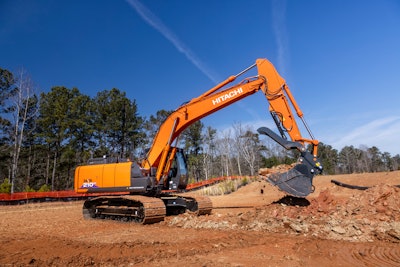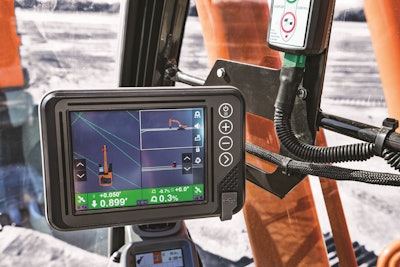
Without question, fuel is one of excavator owners’ and operators’ most considerable operating expenses—an expense that’s become even more significant in recent months.
For example, as recently as April, the average retail price for a gallon of ultra-low-sulfur diesel was $5.12, a 63% increase when compared to April 2021’s average. And on Aug. 1, on-highway diesel fuel cost as much as $6.26 per gallon in California, on average, which is the highest aggregate in the U.S. As evidence of the steady rise in prices, this average is nearly $2 higher per gallon than the total recorded a year ago, according to the U.S. Energy Information Administration.
Although diesel fuel prices are beginning to decline throughout the country, the expense is still influencing excavator owners’ bottom lines substantially, leading them to consider new methods for enhancing their excavators’ fuel efficiency. By implementing the following advice, provided by industry experts from Caterpillar, Hitachi Construction Machinery Americas Inc. (HCMA) and Volvo Construction Equipment, excavator owners can overcome the challenges of fuel cost instability and, in turn, receive a higher ROI for their equipment short and long term.
 Next-gen Caterpillar 374 excavator.Caterpillar
Next-gen Caterpillar 374 excavator.Caterpillar
Utilize Machine Features Fully
To save fuel and lower their operating costs, Brian Stellbrink, excavator market professional at Caterpillar, recommends that excavator owners and operators completely understand their equipment’s features and then fully utilize them to their advantage.
As an example, Caterpillar Next Gen Excavators feature Automatic Engine Shutdown, which helps prevent unnecessary, unproductive idling (a key challenge that many owners and operators are currently encountering), as it shuts off the engine after a certain amount of idling occurs without any hydraulic engagement. Additionally, the excavators have Smart Mode, a power management feature that adjusts power automatically, according to operators’ demands.
“Operators have all the power they need, but automatically burn less fuel in less demanding applications,” Stellbrink said. “In some lighter applications, this can translate to up to 15% less fuel consumption without any compromise, in regards to finishing the job at hand.”
At the same time, owners and operators can also utilize telematics to remotely monitor their fleet, while also better understanding the ways in which they can decrease their fuel consumption by reviewing equipment utilization and idle time data. Furthermore, they can use the excavators’ standard onboard technology to reduce their fuel usage or utilize their Grade Control with Assist, which enables operators to quickly get on grade and then stay there, leading to fewer passes, rework and fuel usage. And, of equal importance, they can utilize the excavators’ onboard payload systems that prevent truck overloading (resulting in expensive fines) and underloading (leading operators to use more trucks—to transport the same amount of material off a job—than they would have otherwise utilized).
“Due to these features, many of our latest excavators are demonstrating fuel efficiency gains of up to 25%, when compared to their respective prior models,” Stellbrink said. “By utilizing these features, owners and operators will increase their fuel efficiency and, in turn, decrease their operating costs as fuel prices continue to fluctuate.”
 Not only does HCMA's TRIAS II hydraulic system reduce fuel consumption, but its enhanced attachment controllability increases production.HCMA
Not only does HCMA's TRIAS II hydraulic system reduce fuel consumption, but its enhanced attachment controllability increases production.HCMA
Implement a Game Changer
Offering users high power and speed, HCMA’s ZX210LC-6 HP excavator has various fuel saving features, including what Patrick Baker, HCMA excavator product manager, product management and engineering, considers a game changer in the excavator industry—the TRIAS II hydraulic system. A three-pump system, it’s able to supply a precise amount of pressurized oil to each actuator. And, as a result of the system’s precision, the excavator achieves high hydraulic efficiency, leading to high performance and decreased fuel consumption.
“It provides better attachment controllability too, leading to an increase in production, along with a further reduction in fuel consumption as operators can finish their jobs quicker and more efficiently,” Baker said.
Meanwhile, the enhanced Boom Recirculating system circulates pressurized oil in the boom cylinder whenever the boom is lowered, thereby enabling the pump’s pressurized oil to be delivered directly to the stick, resulting in more efficient and responsive control for operators. Due to this rise in controllability, operators are able to be more productive as they complete their jobs faster, leading to a reduction in fuel usage.
“Lastly, the ZX210LC-6 HP features Arm Recirculation and Hydraulic Boost systems, which increase arm speed,” Baker added. “Consequently, operators have yet another means to finish their jobs faster, thereby minimizing their operational time and fuel consumption.”
 With Hitachi Solution Linkage 3D Grade Control, the machine controls the boom and bucket as the operator handles the arm.HCMA
With Hitachi Solution Linkage 3D Grade Control, the machine controls the boom and bucket as the operator handles the arm.HCMA
Auto Idling is Key
Aside from high fuel costs, excavator owners are currently encountering a variety of challenges, according to Sejong Ko, product manager, excavators, Volvo Construction Equipment. First, some operators have less experience on excavators than they previously had. And, oftentimes, owners have fewer resources to conduct the same amount of work they once did, so it’s difficult for them to find the time they need to train their operators exactly as they’d prefer to. As a result, it’s vital for owners to ensure operators understand their excavators’ features.
“If owners and managers can take a little time to go over work modes and other helpful features with their operators, they’ll not only gain fuel efficiency, but they’ll also have operators that are better prepared for the future,” Ko said. “It may seem like an inconvenience in the moment, but it’s a worthwhile investment of time. And, if owners and managers simply don’t have enough time to train their operators, they can also utilize their OEMs or dealerships too, which may offer more formalized training.”
One primary feature of Volvo excavators that Ko believes operators must fully understand is the auto idle, which automatically reduces excavators’ rpms after a certain period of inactivity, generally ranging from less than 10 seconds, all the way up to 30 seconds. To turn the feature on or off, some excavators also feature a switch that’s available at operators’ fingertips.
Stressing the significance of auto idle, Ko has illustrated a comparison between two excavators: one that has 50% idle time (Excavator A) and another that has 25% idle time (Excavator B). Due to idle time differences, Excavator A will run for about 2,000 hours annually, while Excavator B will only run for 1,500 hours each year. Within five years, Excavator A will run for 10,000 hours, roughly 2,500 hours less than Excavator B. Not to mention, Excavator B will require five fewer 500-hour service intervals during the five-year period.
“This could equate to a $20,000 difference in resale value, depending on class size, along with the countless gallons of fuel Excavator A would utilize during those additional 2,500 hours,” Ko added.
 Volvo EC550E excavator.Volvo Construction Equipment
Volvo EC550E excavator.Volvo Construction Equipment
Features Reduce Fuel Consumption
To enhance their environmental footprint while decreasing fuel consumption, Volvo excavator owners and operators can also utilize an Engine Auto Shut Down feature, which enables their engines to be set to five-minute timers. After the engine’s control lockout lever has been down for four minutes, a 60-second warning will begin. Once the 60 seconds have passed and the engine still hasn’t been utilized, the excavator will shut off completely. Therefore, the excavator will no longer idle for 40% to 60% of its operator time, which is often the norm for this type of equipment. Hours will no longer be added to the machine either and, above else, fuel won’t be wasted anymore.
Furthermore, operators can use Volvo excavators’ ECO Mode feature too, particularly as they conduct light duty work like digging soft material and grading. Able to control fuel pump flow, in order to avoid inertia whenever overload relief valves are overflowing, the feature also maintains digging power, along with maximum swing efficiency.
“Operators must ensure they know how the ECO Mode feature works on their respective excavators, as it can reduce rpms by approximately 10% on some models,” Ko said. “In addition to decreasing rpms, it also improves fuel efficiency by 5%.”
 Volvo EC380E straight boom demolition excavator.Volvo Construction Equipment
Volvo EC380E straight boom demolition excavator.Volvo Construction Equipment
Enhance Accuracy, Power and Controllability
Capable of relieving pump pressure from Volvo excavators’ engines’ cylinders whenever booms are lowered, a boom float feature, in turn, improves grading accuracy, increases the speed of cycle times and enhances fuel efficiency. Utilized, in particular, for leveling and compacting soil, the feature allows free up-and-down movement of booms, enabling it to effortlessly follow the contours of the ground, as operators never have to worry about adjusting heights regularly.
“It can also be used for truck loading, as the boom float will reallocate pump flow to engines’ bucket and arm cylinders, resulting in improved cycle times whenever hard digging isn’t required,” Ko said.
Aside from enhancing grading accuracy and cycle time speed, operators can also increase power and controllability, while improving their fuel efficiency even further, by utilizing the correct work mode for their respective excavator. According to Ko, operators often select the highest work mode setting that’s available, regardless of the tasks. However, some tasks can be achieved at much lower rpms without any loss in cycle times or performances being noticed at all. In fact, operators could lower their fuel consumption by 10% for each excavator, as long as they run every one at 200 to 300 rpms less than they previously did.
“It should be as simple as possible to balance engine rpm with hydraulic flow, which is why everything is integrated into a single dial on Volvo excavators,” Ko said. “By moving this dial, operators can change the pump flow, along with the engine speed.”
Idle modes are available in two options: I1 for 800 rpm, which saves the most fuel of the two, and I2 for 1,000 rpm, which enables faster warm-up times. Meanwhile, fine modes, which increase hydraulic lifting power by 10%, are available in two options as well—F1 (particularly ideal for finish work like grading) and F2 (ideal for tasks like setting culvert or large pipes in trenches, as it has full power, along with a marginally higher pump flow).
In addition, operators can utilize four general modes, known as G1, G2, G3 and G4, for conventional digging and excavation projects, along with a heavy mode (known simply as H) that offers maximum power, as it’s especially useful for digging in extremely hard terrain.
The Future of Fuel Efficiency
As Stellbrink prepares for the future, he’s confident the excavator industry will continue to achieve further significant gains, with regards to fuel efficiency.
“We have some of the brightest engineers in the industry working hard every day to continue to lower operating costs for excavator owners, while also increasing excavators’ jobsite efficiencies and production capabilities,” he said. “These are very exciting times ahead!”
Baker adds that HCMA will continue to conduct research regarding new excavator features that not only save fuel, but also offer enhanced performance and productivity.
“Machine matched hydraulics, high power and speed, serviceability and, of course, fuel efficiency will remain HCMA’s primary goals,” he said. “And, with this in mind, the company will continue to conduct fuel reduction measures, while also keeping the total cost of ownership low for owners and operators alike.”
As fuel efficiency remains a key issue for excavators for the foreseeable future, Ko also believes alternative power sources will develop rather quickly. For instance, Volvo Construction Equipment is focused on continuing to improve its traditional powertrain and hydraulic control systems, as recent offerings like the EC530EL and EC550EL are increasing fuel efficiency by 10%, when compared to the previous generation of systems. Yet, at the same time, the company is also overseeing advancements of alternative power sources, such as hydrogen fuel cells.
“These developments take time though, as many governments are regulating these efforts and companies are setting their own standards too,” Ko said. “Therefore, diesel will remain in the mix for a while, while internal combustion technology continues to progress as well, including features that will enhance fuel efficiency.”
He added, “There is no single solution. With this in mind, excavator owners will need to find the best mix of changes that’s the most suitable for their own unique operations as they look ahead to the coming months and years.”



















